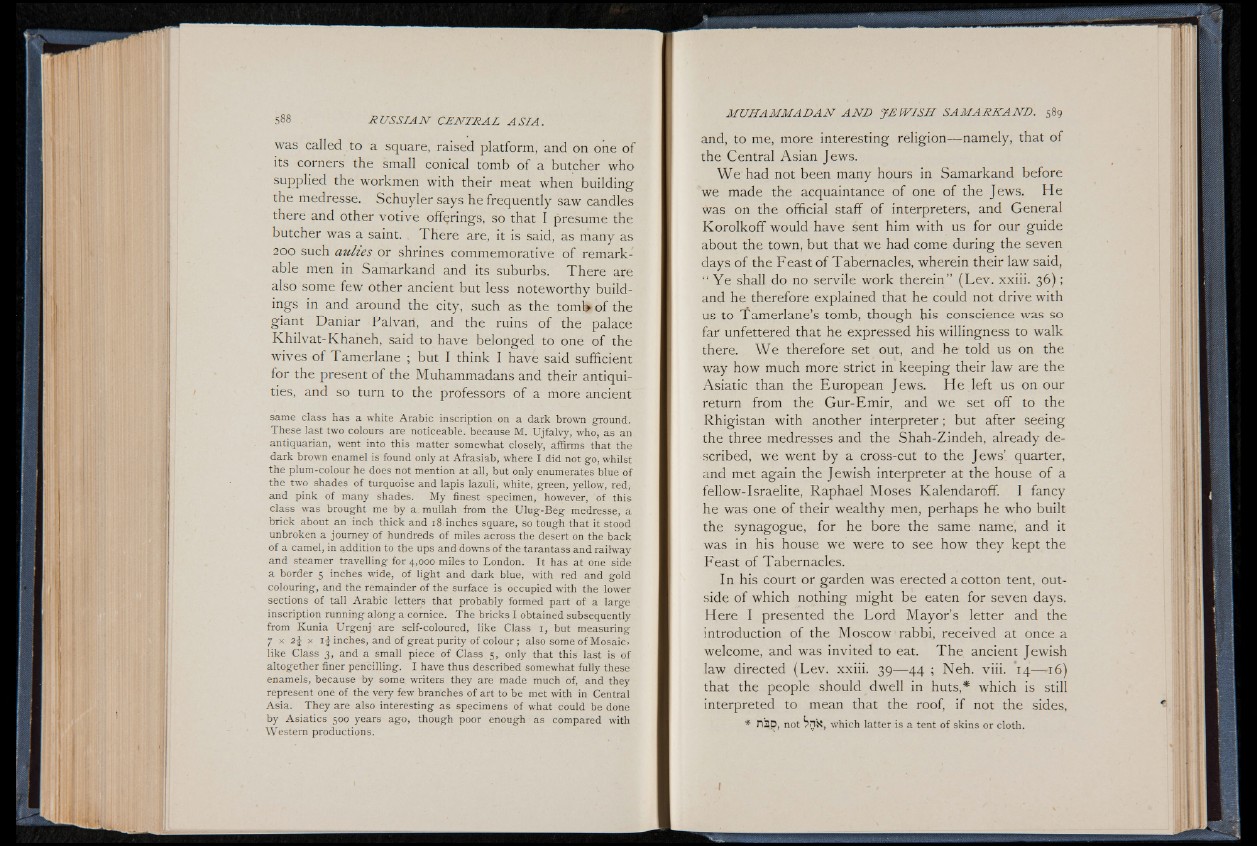
was called to a square, raised platform, and on one of
its corners the small conical tomb of a butcher who
supplied the workmen with their meat when building'
the medresse. Schuyler says he frequently saw candles
there and other votive offerings, so that I presume the
butcher was a saint. There are, it is said, as many as
200 such aulies or shrines commemorative of remarkable
men in Samarkand and its suburbs. There are
also some few other ancient but less noteworthy buildings
in and around the city, such as the toml* of the
giant Daniar Palvari, and the ruins of the palace
Khilvat-Khaneh, said to have belonged to one of the
wives of Tamerlane ; but I think I have said sufficient
for the present of the Muhammadans and their antiquities,
and so turn to the professors of a more ancient
same class has a white Arabic inscription on a dark brown ground.
These last two colours are noticeable, because M. Ujfalvy, who, as an
antiquarian, went into this matter somewhat closely, affirms that the
dark brown enamel is found only at Afrasiab, where I did not go, whilst
the plum-colour he does not mention at all, but only enumerates blue of
the two shades of turquoise and lapis lazuli, white, green, yellow, red,
and pink of many shades. My finest specimen, however, of this
class was brought me by a. mullah from the Ulug-Beg medresse, a
brick about an inch thick and 18,inches square, so tough that it stood
unbroken a journey of hundreds of miles across the desert on the back
of a camel, in addition to the ups and downs o f the tarantass and railway
and steamer travelling for 4,000 miles to London. It has at one side
a border 5 inches wide, of light and dark blue, with red and gold
colouring, and the remainder of the surface is occupied with the lower
sections of tall Arabic letters that probably formed part of a large
inscription running a long a comice. The bricks I obtained subsequently
from Kunia Urgenj are self-coloured, like Class 1, but measuring
7 x z j x 1 \ inches, and of great purity of colour; also some of Mosaic,
like Class 3, and a small piece of Class 5,, only that this last is of
altogether finer pencilling. I have thus described somewhat fully these
enamels, because by some writers they are made much of, and they
represent one of the very few branches of art to be met with in Central
Asia. They are also interesting as specimens of what could be done
by Asiatics 500 years ago, though poor enough as compared with
Western productions.
and, to me, more interesting religion— namely, that of
the Central Asian Jews.
We had not been many hours in Samarkand before
we made the acquaintance of one of the Jews. He
was on the official staff of interpreters, and General
Korolkofif would have sent him with us for our guide
about the town, but that we had come during the seven
days of the Feast o f Tabernacles, wherein their law said,
“ Y e shall do no servile work therein” (Lev. xxiii. 36);
and he therefore explained that he could not drive with
us to Tamerlane’s tomb, though his conscience was so
far unfettered that he expressed his willingness to walk
there. We therefore set out, and he told us on the
way how much more strict in keeping their law are the
Asiatic than the European Jews. He left us on our
return from the Gur-Emir, and we set off to the
Rhigistan with another interpreter; but after seeing
the three medresses and the Shah-Zindeh, already described,
we went by a cross-cut to the Jews’ quarter,
and met again the Jewish interpreter at the house of a
fellow-Israelite, Raphael Moses Kalendaroff. I fancy
he was one of their wealthy men, perhaps he who built
the synagogue, for he bore the same name, and it
was in his house we were to see how they kept the
Feast of Tabernacles.
In his court or garden was erected a cotton tent, outside
of which nothing might be eaten for seven days.
Here I presented the Lord Mayor’s letter and the
introduction of the Moscow rabbi, received at once a
welcome, and was invited to eat. The ancient Jewish
law directed (Lev. xxiii. 39— 44 ; Neh. viii. ’14— -16)
that the people should dwell in huts,* which is still
interpreted to mean that the roof, if not the sides,
* nap, not ^>n's, which latter is a tent of skins or cloth.